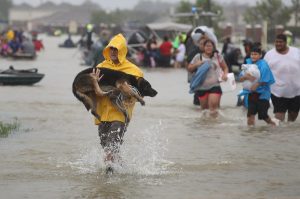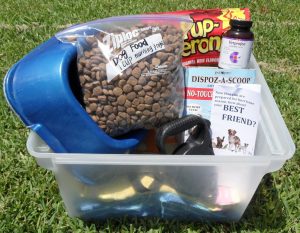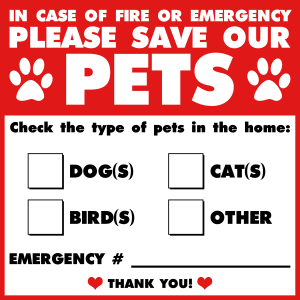 Out west, wildfire season has come early, and in the eastern and Gulf states it’s already hurricane season. In many places, people will be evacuated, often with little or no advance notice. Now is the time to prepare your animal companions for natural disasters.
Out west, wildfire season has come early, and in the eastern and Gulf states it’s already hurricane season. In many places, people will be evacuated, often with little or no advance notice. Now is the time to prepare your animal companions for natural disasters.
In a major disaster, local emergency workers may be stretched to the limit, and it can take days for additional help to arrive from outside your area. The bottom line is that you are the best—maybe even the only—chance your animal has for rescue. It’s really important that you have a plan.
Your plan should cover the different kinds of disasters likely to occur where you live. Do you have hurricanes, tornadoes, or floods? What about wildfires? Earthquakes? You’ll need a plan to evacuate if a fire or flood is headed your way.
Evacuating Your Home
Take your animals. If it’s not safe for you to stay, it isn’t safe for your animals either.
 Have an animal disaster kit ready. Your kit should include carriers, leashes, a litter box, and bowls, as well as a three— to five-day supply of pet food, water, and litter. Don’t forget your animal companions’ medical records and medications. Include current photos of each animal, in case they get separated from you during the evacuation. A plastic storage bin is a great way to keep your kit portable and dry. Make sure you can get to your disaster kit quickly.
Have an animal disaster kit ready. Your kit should include carriers, leashes, a litter box, and bowls, as well as a three— to five-day supply of pet food, water, and litter. Don’t forget your animal companions’ medical records and medications. Include current photos of each animal, in case they get separated from you during the evacuation. A plastic storage bin is a great way to keep your kit portable and dry. Make sure you can get to your disaster kit quickly.
Prepare your animals early. It can be very hard to load a frightened cat into a carrier or to quickly find a dog who doesn’t always come when called. You may want to confine your animals in the house (or in their carriers) before the actual evacuation order comes. It’s also a good idea to practice evacuating the house with all your animals, in preparation for the day when a firefighter knocks on your door and says you have to be out in five minutes. Of course, your animals should be microchipped and wearing ID tags with your name and cell phone number.
Know where to go. Do you have friends or family nearby who can host you and your animals? Do you know which hotels take animals? Consider including a list of hotels in your disaster kit.
Have an arrangement with a friend. What if you’re not home when your neighborhood is evacuated? A mutual aid agreement with a neighbor or friend will ensure that your animals get out in time.
 Have rescue alert stickers in place. A sticker in windows on all four sides of your residence will alert fire or rescue workers to the fact that your animals may be trapped inside.
Have rescue alert stickers in place. A sticker in windows on all four sides of your residence will alert fire or rescue workers to the fact that your animals may be trapped inside.
Sheltering at Home
Make sure you have plenty of supplies. Have a minimum of 10 days of food and supplies at home. It’s much less stressful for animals to stay in a familiar environment, but if you run out of supplies, you may have to evacuate with your animals to a shelter.
Have a battery-operated radio. If you are sheltering at home to avoid exposure to a toxic spill or a flu epidemic, you’ll need to know when the danger is over. Cell phones lose power and cell phone towers can be put out of commission. A radio (with lots of extra batteries!) will enable you to find out when the coast is clear.
 Consider taking a dog and cat first-aid class. In an emergency, a veterinarian may not be immediately available. You might save your dog’s or cat’s life in a disaster by knowing how to stop bleeding or treat for shock. Even without a disaster, your knowledge of how to treat heat stroke or choking may save an animal’s life. To find an animal first-aid class, contact your local chapter of the American Red Cross, or check with your nearest animal shelter.
Consider taking a dog and cat first-aid class. In an emergency, a veterinarian may not be immediately available. You might save your dog’s or cat’s life in a disaster by knowing how to stop bleeding or treat for shock. Even without a disaster, your knowledge of how to treat heat stroke or choking may save an animal’s life. To find an animal first-aid class, contact your local chapter of the American Red Cross, or check with your nearest animal shelter.
If you don’t already have an animal disaster kit, take a few minutes today to put a basic one together. Here’s some more information on disaster planning for your animals.
Be prepared, stay safe, and please take a moment to watch this video from an old friend of mine!
Peace to ALL the animal with whom we share this planet.
